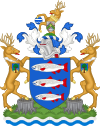
The Coronation Stone is an ancient sarsen stone block which is believed to have been the site of the coronation of seven Anglo-Saxon kings. It is currently located next to the Guildhall in Kingston upon Thames, England. Kingston is now a town in the Royal Borough of Kingston Upon Thames in Greater London.
Toponymy
In Old English, tun, ton or don meant farmstead or settlement, so the name Kingston appears to mean farmstead of the kings. A local legend that these Saxon coronations gave Kingston its name is contradicted by the records of the 838 council.
History
Æthelstan was consecrated king at Kingston in 925, Eadred in 946 and Æthelred the Unready in 979. There is also some evidence that Edward the Elder, Edmund I, Eadwig and Edward the Martyr were consecrated in the town.

According to John Stow, writing in the late sixteenth century, Æthelstan was crowned on a stage in the market place, but it was later believed that the kings were crowned in the ancient church of St Mary, which collapsed in 1730. A large stone block was recovered soon afterwards from the ruins of the chapel, and it has since been regarded as the "Coronation Stone" of the Kings of the English. It was used for a time in the late 18th century to the early 19th century as a mounting block, but in 1850 it was placed in the market place on a plinth in front of the old Town Hall (on the site now occupied by the 'Market House' today). which had the names of the seven kings believed to have been crowned on it inscribed around the side.
Future plans
In 2017, Kingston Council was considering an option of re-siting the coronation stone from the Guildhall's frontage back to its original location within the churchyard of Kingston's old parish church, All Saints' Church.
See also
- List of individual rocks
- Blarney Stone (Ireland)
- Stone of Scone (Scotland)
- Duke's Chair (Austria)
- Edward Faraday Odlum
- History of Scotland
- Lia Fáil (Ireland)
- Omphalos
- Prince's Stone (Slovenia)
- Stone of Jacob
- Stones of Mora (Sweden)
Notes
- Dickens, Charles Jr. (1994) . Dickens's Dictionary of the Thames (facsimile ed.). Devon: Old House Books. ISBN 1-873590-12-1.
- ^ Keynes, Simon (2001). "Kingston-upon-Thames". In Michael Lapidge; John Blair; Simon Keynes; Donald Scragg (eds.). The Blackwell Encyclopedia of Anglo-Saxon England. Blackwell Publishing. ISBN 978-0-6312-2492-1.
- Historic England. "Coronation Stone (1080066)". National Heritage List for England. Retrieved 21 August 2020.
- "Where England Began". All Saints Church, Kingston upon Thames. Retrieved 18 January 2017.
Further reading
- Bell, William (1858). "The Kingston Morasteen" . Surrey Archaeological Collections. 1: 27–56.
External links
 Media related to Coronation Stone at Wikimedia Commons
Media related to Coronation Stone at Wikimedia Commons
| Royal Borough of Kingston upon Thames | ||
|---|---|---|
| Districts |   | |
| Attractions | ||
| Bridges and tunnels | ||
| Parks and open spaces | ||
| Constituencies | ||
| Rail stations | ||
| Places of worship | ||
| Sport | ||
| Other topics | ||
51°24′30″N 0°18′24″W / 51.4084°N 0.3068°W / 51.4084; -0.3068
This article related to the history of England is a stub. You can help Misplaced Pages by expanding it. |
- History of the Royal Borough of Kingston upon Thames
- Monuments and memorials in London
- Grade I listed buildings in the Royal Borough of Kingston upon Thames
- English monarchy
- Anglo-Saxon archaeology
- Coronation stones
- Sacred rocks
- Tourist attractions in the Royal Borough of Kingston upon Thames
- English history stubs